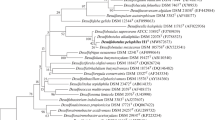Abstract
A strictly anaerobic, thermophilic, fatty acids-degrading, sporulating sulfate-reducing bacterium was isolated from geothermal ground water. The organism stained Gram-negative and formed gas vacuoles during sporulation. Lactate, ethanol, fructose and saturated fatty acids up to C18 served as electron donors and carbon sources with sulfate as external electron acceptor. Benzoate was not used. Stoichiometric measurements revealed a complete oxidation of part of butyrate although growth with acetate as only electron donor was not observed. The rest of butyrate was oxidized to acetate. The strain grew chemolithoautotrophically with hydrogen plus sulfate as energy source and carbon dioxide as carbon source without requirement of additional organic carbon like acetate. The strain contained a c-type cytochrome and presumably a sulfite reductase P582. Optimum temperature, pH and NaCl concentration for growth were 54°C, pH 7.3–7.5 and 25 to 35 g NaCl/l. The G+C content of DNA was 50.4 mol %. Strain BSD is proposed as a new species of the spore-forming sulfate-reducing genus Desulfotomaculum, D. geothermicum.
Similar content being viewed by others
References
Akagi, J.M. & V. Adams (1973) Isolation of a bisulfite reductase activity from Desulfotomaculum nigrificans and its identification as the carbon monoxide-binding pigment 582. J. Bacteriol. 116: 392–396
Campbell, I.L. & R. Singleton (1986) Endospore-forming Gram-positive rods and cocci. In: P.H.A. Sneath, N.S. Mair, M.E. Sharpe & J.G. Holt (Eds) Bergey's Manual of systematic Bacteriology. Vol. 2. (pp. 1200–1202). Williams & Wilkins: Baltimore
Cord-Ruwisch, R. (1984) A quick method for the determination of dissolved and precipitated sulfides in culture of sulfate-reducing bacteria. J. Microbiol. Methods 4: 33–36
Cord-Ruwisch, R. & J.L. Garcia (1985) Isolation and characterization of an anaerobic benzoate-degrading spore-forming sulfate-reducing bacterium, Desulfotomaculum sapomandens sp. nov. FEMS Microbiol. Lett. 29: 325–330
Cord-Ruwisch, R., B. Ollivier & J.L. Garcia (1986) Fructose degradation by Desulfovibrio sp. in pure culture and in coculture with Methanospirillum hungatei. Current Microbiol. 13: 285–289
Imhoff-Stuckle, D. & N. Pfennig (1983) Isolation and characterization of a nicotinic acid-degrading sulfate-reducing bacterium, Desulfococcus niacini sp. nov. Arch. Microbiol. 136: 194–198
Klemps, R., H. Cypionka, F. Widdel & N. Pfennig (1985) Growth with hydrogen and further physiological characteristics of Desulfotomaculum species. Arch. Microbiol. 143: 203–208
Nazina, T.N. & E.P. Rozanova (1978) Thermophilic sulfate-reducing bacteria from oil strata. Mikrobiologiya 47: 142–148
Pfennig, N. (1978) Rhodocyclus purpureus gen. nov. and sp. nov., a ring-shaped, vitamin B12-requiring member of the family Rhodospirillaceae. Int. J. Syst. Bacteriol. 28: 283–288
Postgate, J.R. (1959) Sulphate-reduction by bacteria. Ann. Rev. Microbiol. 13: 505–520
Trudinger, P.A. (1970) Carbon monoxide-reacting pigment from Desulfotomaculum nigrificans and its possible relevance to sulfite reduction. J. Bacteriol. 104: 158–170
Widdel, F. & N. Pfennig (1977) A New anaerobic, sporing, acetate-oxidizing, sulfate-reducing bacterium, Desulfotomaculum (emend) acetoxidans. Arch. Microbiol. 112: 119–122
Widdel, F. & N. Pfennig (1981a) Sporulation and further nutritional characteristics of Desulfotomaculum acetoxidans. Arch. Microbiol. 129: 401–402
Widdel, F. & N. Pfennig (1981b) Studies on dissimilatory sulfate-reducing bacteria that decompose fatty acids. I. Isolation of new sulfate-reducing bacteria enriched with acetate from saline environments. Description of Desulfobacter postgatei gen. nov., sp. nov. Arch. Microbiol. 129: 395–400
Widdel, F., G.W. Kohring & F. Mayer (1983) Studies on dissimilatory sulfate-reducing bacteria that decompose fatty acids. III. Characterization of the filamentous gliding Desulfonema limicola gen. nov. sp. nov. and Desulfonema magnum sp. nov. Arch. Microbiol. 134: 286–294
Widdel, F. & N. Pfennig (1984) Dissimilatory sulfate-or sulfur-reducing bacteria. In: N.R. Krieg & J.G. Holt (Eds) Bergey's Manual of systematic Bacteriology. Vol. 1. (pp. 666–671). Williams and Wilkins, Baltimore
Widdel, F. (1987) Microbioloy and ecology of sulfate- and sulfur- reducing bacteria. In: A.J.B. Zehnder (Ed) Environmental Microbiology of Anaerobes. John Wiley: New York, London (in press)
Author information
Authors and Affiliations
Rights and permissions
About this article
Cite this article
Daumas, S., Cord-Ruwisch, R. & Garcia, J.L. Desulfotomaculum geothermicum sp. nov., a thermophilic, fatty acid-degrading, sulfate-reducing bacterium isolated with H2 from geothermal ground water. Antonie van Leeuwenhoek 54, 165–178 (1988). https://doi.org/10.1007/BF00419203
Received:
Accepted:
Issue Date:
DOI: https://doi.org/10.1007/BF00419203




